IBRO Course in Egypt for African Neuroscience Teachers Uses NIA2
Jan 8, 2010 • Posted by Ann StuartThe 2nd Teaching Tools School and Workshop, was held at Fayoum University, Egypt, in December 2009, as part of a program designed to train teachers of neuroscience in Africa. Seven African countries were represented. Team based laboratory learning and other methods of engaging students is a focus of this program. This year NIA2 was introduced for teaching basic principles of neurophysiology. Professor Sharon Juliano of the USUHS, and an organizer of the course, reports: “The participants gained substantially from using NIA2 and universally indicated that their appreciation and understanding of concepts in neurophysiology improved considerably.”
The Workshop is supported by the African Regional Committee of IBRO, the Society for Neuroscience, and the National Academy of Sciences (USA).
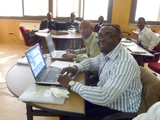

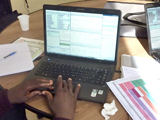
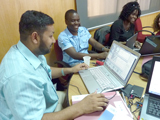
Journal of Undergraduate Neuroscience Education publishes article on NIA2
Sept 20, 2009 • Posted by Ann StuartI have published an article in the online Journal of Undergraduate Neuroscience Education (JUNE) entitled “Teaching Neurophysiology to Undergraduates using Neurons in Action.”
http://www.funjournal.org/downloads/200981/stuart81.pdf
This article details the development of the Neurons in Action teaching tool, summarizes the content of the new tutorials in Version 2, and describes some of the ways in which we and colleagues have used NIA in undergraduate lectures and labs.
Tibetan monks and nuns use NIA2 to learn about neurons
July 7, 2009 • Posted by Ann StuartFaculty members from Emory University recently used Neurons in Action 2 to teach neurophysiology to Tibetan monks and nuns at a Buddhist college campus in Dharamsala, India, as part of the Emory Tibet Science Initiative (http://tibet.emory.edu/news/index.html#etsi_200).
The Dalai Lama has long advocated that science, especially neuroscience, be taught in Tibetan monasteries and schools in exile. The following email from Dieter Jaeger, an Associate Professor at Emory, reports that Neurons in Action 2 was clearly a success.
Hi Ann,
I just came back from Dharamsala with a ton of fascinating experiences and a bunch of pictures! NIA2 was a big success with the monks and nuns, and we had 2 sessions. As you can see, it was quite crowded! The last picture is from a discussion session "Buddhism and Western Science".
Thanks again for letting us use NIA2 in India. Some monks took it home to their monastery, so there is no telling how big a hit it will be!
Best, Dieter
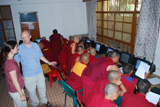
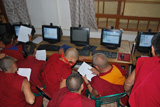
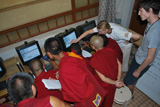
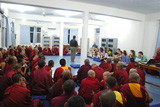
Evaluation of NIA2 for the NSF is complete
May 5, 2009 • Posted by Ann StuartThe evaluation team of Dr. Mary Beth Searcy and Dr. Jill Thomley from the Department of Mathematics at Appalachian State University (NC) has submitted their report. The Summary from the report may be found under About/Evaluation for NSF. The final paragraph of the Summary is quoted here:
"Neurons in Action Version 2 (NSF DUE Award #0442748) Final Evaluation Report – Executive Summary 2
"In conclusion, the evaluation team would like to state that we believe that the Neurons in Action Version 2 project is one of the most exciting and necessary innovations currently in development for neuroscience education today. It was a tremendous pleasure to be involved in such a dynamic process with investigators and educators as visionary as Ann Stuart and John Moore. For them, the NIA2 project is the realization of concepts and ideas that they have explored and struggled with presenting to students throughout their careers. Technology has finally made implementing many of their visions a reality. We want to encourage them to consider the comments we have made about the achievements of NIA2 to date, as well as the suggestions made by everyone who provided feedback about the NIA2 materials, in order to make even greater gains in the future. It is clear that the instructors using NIA2 see its worth, and are clamoring for more."
Physics prof endorses NIA2
Oct 21, 2008 • Posted by Ann StuartRhonda Dzakpasu, Assistant Professor in the Department of Physics at Georgetown University, sent me this endorsement:
“My first exposure to NIA was in 2005 during a summer course at the MBL in Woods Hole, MA. This was also my introduction to neurobiology and NIA was a great way to start. The tutorials are well written and it was comforting to know that a misstep on my behalf would only result in resetting the program at worse, not destroying a biological preparation or a piece of expensive electrophysiological equipment! The software is very user-friendly and is a fun and painless way to learn neurobiology.
“I did not have the opportunity to work with NIA again until I started my faculty position at Georgetown University in 2008. I organized a NIA2 seminar and workshop for first-year graduate students in the Interdisciplinary Program in Neuroscience. Ann Stuart was gracious enough to visit us and gave a command performance. Her presentation of the software was well received by both faculty and students and several of the faculty will purchase NIA2 for use in their classes.
“I will finally have the chance to work intimately with NIA when I offer a month-long research module to undergraduate students in our Cognitive Science program. This module will be designed so that students will work with the NIA2 program and then compare the results from their tutorials with real experiments in which they will perform intracellular recordings from dissociated cultures.
“NIA is an excellent pedagogical tool for both the beginning and advanced neurobiology student. It will become the centerpiece of my neuroscience teaching component at Georgetown University.”
NIA2 workshop in the Interdisciplinary Program in Neurosciences at Georgetown University Medical Center is timed to compliment coursework
Oct 1, 2008 • Posted by Ann StuartOn September 30 I gave a 4-hour workshop on NIA to the lively, engaged students of the Georgetown Neurosciences Program, as well as several faculty, preceded by a seminar presenting an overview of NIA and its background. The students each sat at a computer running a copy of NIA2 as I worked through major points from selected tutorials. The timing of the workshop, midway through the students' electrophysiology course and a week before the exam, was perfect.
We started with the Membrane Tutorial, focusing on capacitance as neuronal membrane area and the relation between capacitance and dV/dt. This tutorial drives home the importance of the rate of change of the voltage in getting a cell to fire. Next we did the Equilibrium Potentials tutorial, which is targeted to increasing an understanding of the resting potential, the action potential, and reversal potentials.
After a break we turned to the Na Action Potential tutorial, concentrating on the surprising pattern of the Na current in order to make clear the Ohm's Law relation between current, conductance, and driving force. After using the first experiment of the Threshold tutorial to resolve a discussion about whether there is or is not a voltage threshold, we did the entire Chattering Channels tutorial.
With energy still remaining in both me and the students, we zipped through features of the Unmyelinated Axon and Myelinated Axon tutorials. We decreased the diameter of the unmyelinated squid axon in order to slow the action potential, and played with the number of myelin wraps in the myelinated frog axon to find the optimal number. Finally, we ran the simulation in the Site of Impulse Initiation tutorial. It was a whirlwind tour of NIA that left us all worn out and satisfied!
Apologies for embarrassing error found in NIA 2.0
Oct 1, 2008 • Posted by Ann StuartThe representation of Ohm's Law is incorrect at the top of the page that comes up when selecting this equation from the Equations pull-down menu. Correct: E = I*R. Incorrect: E does NOT equal I/R. Probably others have seen this error and cluck-clucked. The authors welcome emails pointing out errors so that they may be corrected on the next CD batch. Please email me at stuart@med.unc.edu.
Yale Journal of Biology and Medicine publishes positive review of NIA2
July 22, 2008 • Posted by Ann Stuarthttp://www.pubmedcentral.nih.gov/articlerender.fcgi?artid=2442728
NIA2 is a hit with the students in the SPINES course at the Marine Biological Laboratory
June 25, 2008 • Posted by Ann StuartThe 18 students of the Summer Program in Neuroscience, Ethics and Survival (SPINES) just finished a 6-day week of using NIA2 to solidify their understanding of basic neurophysiology. For me, one pleasure in teaching a course at the MBL is that there are no exams. Free of exam expectations, the students can learn at their own pace and thus enjoy the process. Nor are there competing pressures on the students. They do not have to "get done" so as to be somewhere else.
As we heard last year, the students said they loved learning this challenging material in NIA's hands-on manner. Even those who had backgrounds in psychology rather than cellular neuroscience appreciated the NIA learning tool and realized they could use it in the future if they had to teach this subject.
After an introduction by me using the Equilibrium Potentials tutorial, the students spent the first two days working through the Membrane and Na Action Potential tutorials. The students seemed immediately unafraid of capacitance when they realized that it may be thought of as membrane area.
They then worked through voltage and patch clamping, and then the Axons tutorials with their moving signals. Near the end of the week, students chose other tutorials that particularly interested them and presented the essence of the chosen tutorial to the rest of the class. Some students even took on the challenging Kinetics and Dynamic Threshold tutorials, became clearly excited about these advanced subjects, and then explained them clearly to their peers. Altogether the week was extremely satisfying to this NIA author as I watched students truly enjoy learning about how neurons work.
Article detailing various teaching venues for NIA is published online
May 20, 2008 • Posted by Ann StuartThe online journal Brains, Minds and Media has published my illustrated article entitled "Neurons in Action in Action." The article, based on my experience and that of many colleagues, has the following sections:
- Using Neurons in Action in lecture
- Didactic lecture: making lecture lively with movies and sound
- Interactive lecture: the educational value of suspense
- Using Neurons in Action in an undergraduate laboratory setting
- Turning students loose with NIA in a computer lab
- Using NIA in conjunction with a wet lab
- Using Neurons in Action in a graduate student course
- Using Neurons in Action for premed or medical students
I am hoping that this article will be encouraging and useful to anyone who may be intrigued by NIA but faces the usual energy barrier of introducing new technology into their teaching.
The article is published in a special issue of Brains, Minds and Media entitled Interaction Educational Media for the Neural and Cognitive Sciences:
http://www.brains-minds-media.org/archive/1433/
Article (HTML): http://www.brains-minds-media.org/archive/1401/
Article (PDF): http://www.brains-minds-media.org/archive/1401/bmm1401.pdf
Williams College Professor Discovers NIA2
May 18, 2008 • Posted by Ann StuartProfessor Steve Zottoli sent me this email about using NIA2:
I want to share the good news that I followed through on a promise to Ann. When she brought a copy of Neurons in Action to me last summer at the MBL, I promised that I would do more than look at the cover. First, I attended the session that both of you held for the MBL community on Neurons in Action. Second, after your inspiring presentation, I opened the cover and started to read but other obligations took me away from actually playing with the tutorials. Realizing that another year might go by without any follow-through on my part, I decided to use Neurons in Action as the text for my upper level Neurobiology course. This commitment forced me to actually load the CD and start my journey. What fun! In my typical fashion I did not read anything but immersed myself in the tutorials. I quickly realized that I had the power to do experiments that led to more experiments and sometimes questions that I could not easily answer. What more could an experimental scientist wish for!
The students were assigned a tutorial each week that coincided with the lecture material. As questions arose in the classroom concerning my lectures, I challenged the students to answer them by doing experiments with me on the big screen. The students were given challenge questions and were encouraged to use Neurons in Action to answer them (the equivalent of problem sets). My most memorable experience was when a student raised her hand and rather than directing a question to me she asked the question to Neurons in Action!
I wish to congratulate you both on one of the best teaching tools available for neuroscience. I also commend you for providing such an interactive tool for an affordable price. I applaud your selfless dedication to education.
Workshops on using NIA in lecture were held at SYNAPSE (Symposium for Young Neuroscientists and Professors of the Southeast) in Charleston SC
Apr. 22, 2008 • Posted by Ann StuartOn March 15, 2008, I offered workshops, attended primarily by faculty teaching undergraduates, on how to use NIA2 in teaching, especially in lecture. Much of the conversation focused on using NIA interactively by changing a parameter for a simulation and then asking the class to predict the outcome of the simulation before running it. Some of the workshop attendees teach very large lecture classes where the students are equipped with clickers; we discussed how students could then vote with the clicker for their choice of outcome. In smaller classes, more discussion of the possibilities could precede the simulation. I also called attention to the minimovies, which we designed for importing into lecture presentations when not enough time is available to run simulations. Attendees enjoyed the sound that accompanies the action potential minimovies and thought it would engage students.
Version 2.0.1 incorporates patches for Vista and Firefox
Dec. 12, 2007 • Posted by Ann StuartSinauer is currently shipping Version 2.0.1. This version incorporates an update patch that was previously required for Windows Vista users so that the NEURON simulations would run. It also allows Windows users who are already using Firefox as their browser to run NIA2 without experiencing conflicts between user and NIA2 preferences.